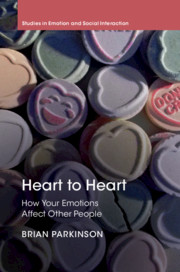Book contents
- Heart to Heart
- Studies in Emotion and Social Interaction
- Heart to Heart
- Copyright page
- Dedication
- Contents
- Figures
- Preface
- Acknowledgements
- Chapter 1 What’s at the Heart of Emotions?
- Chapter 2 Words and Concepts
- Chapter 3 Facial Activity and Emotion Expression
- Chapter 4 Explaining Emotional Influence
- Chapter 5 Regulating Emotions
- Chapter 6 Social Functions
- Chapter 7 Groups, Teams and Crowds
- Chapter 8 Working with Emotions
- Chapter 9 Reorientation
- References
- Index
- Studies in Emotion and Social Interaction
Chapter 9 - Reorientation
Published online by Cambridge University Press: 28 October 2019
- Heart to Heart
- Studies in Emotion and Social Interaction
- Heart to Heart
- Copyright page
- Dedication
- Contents
- Figures
- Preface
- Acknowledgements
- Chapter 1 What’s at the Heart of Emotions?
- Chapter 2 Words and Concepts
- Chapter 3 Facial Activity and Emotion Expression
- Chapter 4 Explaining Emotional Influence
- Chapter 5 Regulating Emotions
- Chapter 6 Social Functions
- Chapter 7 Groups, Teams and Crowds
- Chapter 8 Working with Emotions
- Chapter 9 Reorientation
- References
- Index
- Studies in Emotion and Social Interaction
Summary
This concluding chapter summarises ideas and evidence presented earlier in the book and sets out the general principles of the relation-alignment approach to emotional influence. I develop the argument that emotions are embodied orientations to objects, events or people that converge or conflict with other people’s orientations, rather than internal mental states that only make indirect contact with the social world. Their effects and functions depend crucially on the dynamic interpersonal, intergroup, organisational and societal systems within which they operate. Emotion’s range of social influence extends cumulatively over the course of socialisation, as caregivers deliver culturally informed responses to children’s increasingly articulated orientations. The capacity to use words and faces in symbolically mediated pragmatic communications ultimately permits conventionalised forms of social influence that are less constrained by immediately pressing situational concerns, facilitating more strategic forms of interpersonal regulation. However, even fully socialised adults remain susceptible to less explicit forms of emotional influence, and do not necessarily register the meaning of the emotional operations shaping their own dynamic responses. Thus, our emotions affect other people in a variety of ways, none of which depend directly on the mediated transmission of private meanings. People learn to keep their emotional inclinations to themselves only after becoming sensitive to their prior social effects.
Keywords
- Type
- Chapter
- Information
- Heart to HeartHow Your Emotions Affect Other People, pp. 322 - 345Publisher: Cambridge University PressPrint publication year: 2019

